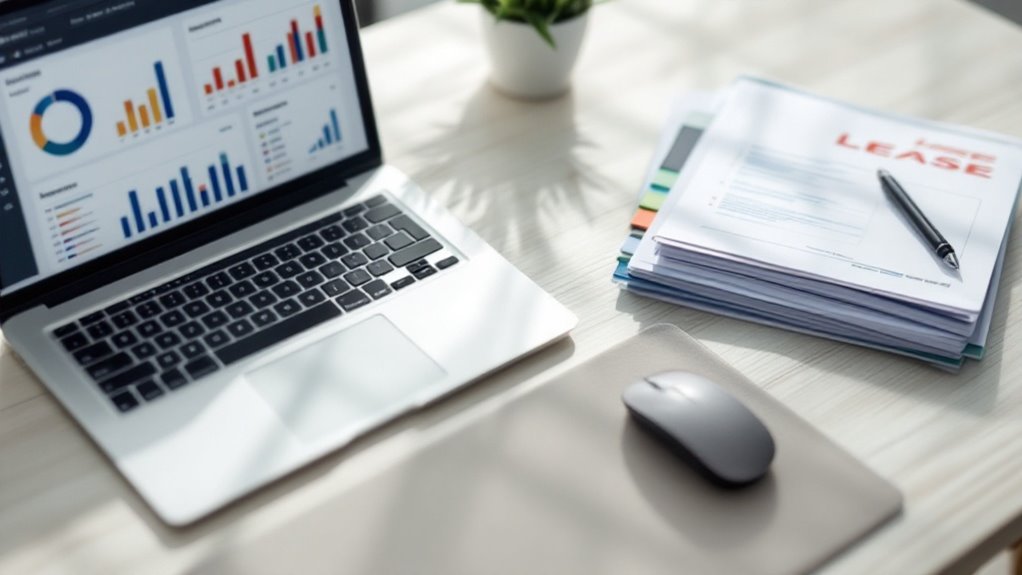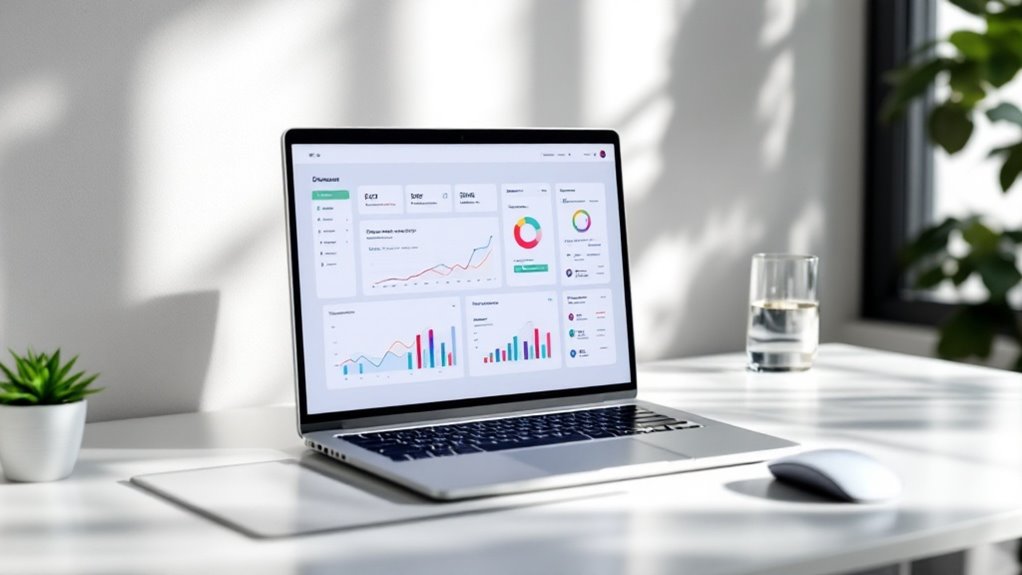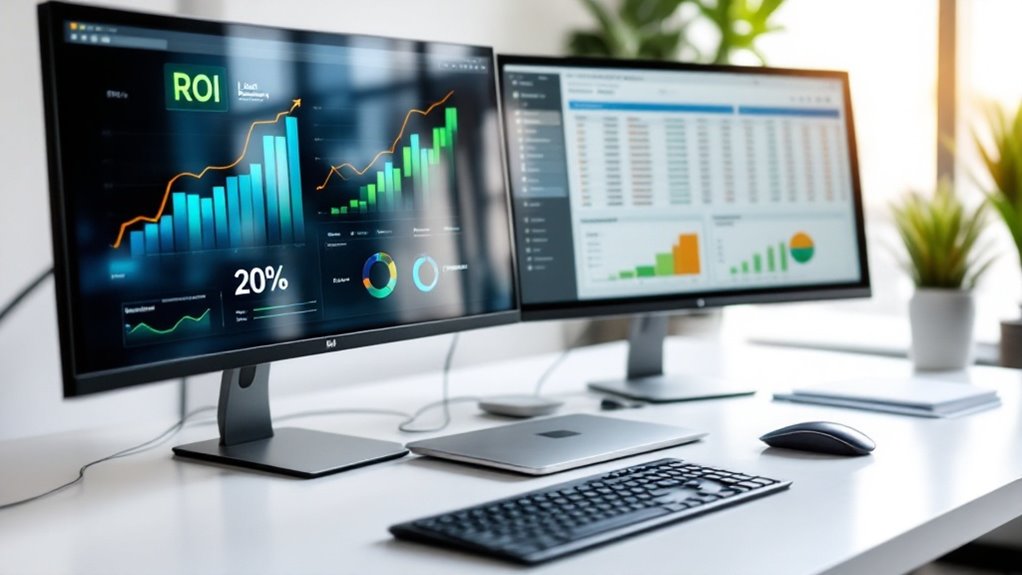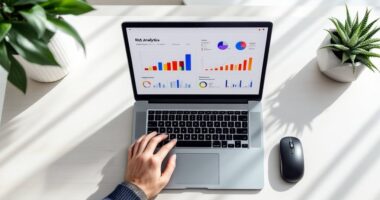Lease accounting software helps small businesses automate compliance with ASC 842 and IFRS 16 standards through streamlined data management and reporting. These solutions offer automated calculations, payment scheduling, and journal entries while maintaining centralized storage for lease contracts. Key features include real-time tracking, integrated reporting, and simplified month-end closures. Modern platforms reduce manual errors by up to 60% and can cut costs by 30% through ERP integration. Understanding the core components guarantees ideal selection for specific business needs.
Quick Overview
- Choose cloud-based lease accounting software with built-in ASC 842 compliance to avoid costly implementation and maintenance fees.
- Look for solutions offering free trials and simplified pricing structures designed specifically for small business budgets.
- Select software with automated calculations and journal entries to reduce manual work and minimize accounting staff requirements.
- Prioritize platforms that integrate easily with popular small business accounting systems like QuickBooks or Xero.
- Focus on user-friendly interfaces with basic reporting features to ensure staff can quickly learn and utilize the system.
Understanding Core Features of Small Business Lease Accounting Software

Three essential features define modern lease accounting software for small businesses, starting with compliance capabilities for ASC 842 and IFRS 16 standards.
These compliance requirements guarantee accurate financial reporting and help businesses maintain regulatory adherence.
The second core feature involves automated calculations and streamlined data entry processes.
This automation handles complex lease management tasks, including payment schedules and journal entries, reducing manual errors and saving valuable time for small business teams.
Finally, effective lease accounting software must integrate seamlessly with existing business systems.
This integration provides real-time insights into lease portfolios and simplifies month-end processes.
Modern platforms offer centralized storage for lease contracts, making it easier to track renewals, manage expenses, and generate detailed reports for decision-making purposes.
Key Benefits of Automating Lease Management
The adoption of automated lease management systems delivers substantial advantages for small businesses seeking to streamline their operations. Lease accounting software enhances operational efficiency while ensuring compliance with ASC 842 and IFRS standards.
| Benefit Category | Impact | Business Value |
|---|---|---|
| Compliance | Automated Standards Adherence | Reduced Risk |
| Efficiency | Real-time Tracking | Better Decision-Making |
| Documentation | Integrated Reporting | Audit-Ready Records |
Automating lease management greatly reduces manual data entry and enables faster month-end closures. The integration of real-time tracking features provides enhanced visibility into lease terms and payment schedules, supporting informed financial decision-making. Small businesses benefit from streamlined processes and audit-ready documentation, allowing them to focus resources on strategic initiatives while maintaining compliance requirements.
Choosing the Right Software for Your Lease Portfolio

Selecting ideal lease accounting software requires careful consideration of both immediate operational needs and long-term compliance requirements. Small businesses should focus on solutions that streamline the lease accounting process while ensuring compliance with ASC standards through robust automation features.
When evaluating lease management software options, businesses should prioritize platforms that offer a centralized database and integrate with existing systems seamlessly.
Key features to assess include a user-friendly interface, extensive reporting capabilities, and tools that simplify financial operations.
To make an informed decision, companies can:
- Test available free trials
- Review integration possibilities with current software
- Assess the platform’s ability to scale with growing lease portfolio needs
- Verify that automated features align with specific business workflows
- Confirm the software’s compliance monitoring tools
Essential Compliance and Reporting Capabilities
Robust compliance and reporting capabilities stand at the core of effective lease accounting software for small businesses. Modern solutions guarantee compliance with ASC 842 and IFRS 16 standards through automated reporting features and centralized databases.
These systems streamline financial reporting while maintaining accuracy in user-friendly lease management interfaces.
Key compliance and reporting features include:
- Automated generation of audit-ready financial statements with detailed cash flow analysis
- Customizable disclosure reports tailored to specific lease portfolios
- Centralized data management for enhanced visibility and accuracy
The software’s extensive reporting tools help small businesses maintain compliance while simplifying complex accounting requirements.
Through automated processes and organized data structures, businesses can efficiently track their lease obligations and generate necessary documentation for stakeholders and regulatory bodies.
Maximizing ROI Through Effective Implementation

Maximizing return on investment through effective lease accounting software implementation requires strategic planning and careful attention to key operational factors. Small businesses can achieve significant benefits by focusing on key implementation aspects that drive value and efficiency.
| Implementation Focus | Business Impact |
|---|---|
| Automating lease management | 60% time savings |
| ERP system integration | 30% cost reduction |
| Compliance monitoring | Reduced risk exposure |
| Real-time reporting | Enhanced decision-making |
The implementation of a thorough lease accounting solution supports ASC 842 and IFRS compliance while providing enhanced financial visibility. By leveraging tailored reporting features and real-time insights, organizations can improve their strategic financial planning processes. Integration with existing ERP systems streamlines data management, while automated workflows boost operational efficiency. This systematic approach helps small businesses maximize their software investment while maintaining robust compliance standards.
Frequently Asked Questions
How Much Does Lease Accounting Software Cost?
Lease accounting software typically costs between $99 and $299 per user monthly.
Pricing often follows a tiered structure based on the number of leases managed. While basic packages start at the lower end, more extensive solutions with advanced features command higher prices.
Additional expenses may include implementation fees, training costs, and system integration charges.
Some providers offer free trials for small portfolios, allowing businesses to test functionality before committing.
What Is the Easiest Accounting Software to Use for a Small Business?
Looking for a user-friendly accounting solution that won’t give you a headache? For small businesses, LeaseGuru stands out as the easiest option due to its straightforward interface and simple navigation.
Its features are designed specifically for businesses managing fewer than 25 leases, making daily tasks less intimidating.
iLeasePro follows closely behind, offering intuitive controls and automated tracking.
Both solutions minimize the learning curve while ensuring proper accounting standards compliance.
How to Do Accounting for Leases?
To properly account for leases, businesses should follow these essential steps:
1. Classify the lease as either operating or finance based on ASC 842 standards.
2. Record initial lease liability and right-of-use asset.
3. Create monthly journal entries for:
- Lease payments
- Interest expense
- Asset depreciation
4. Maintain detailed records of:
- Payment schedules
- Lease terms
- Modifications
Regular review of lease agreements guarantees accurate financial reporting and compliance with accounting standards.
Is There a Free Accounting Software for Small Businesses?
According to recent surveys, 82% of small businesses rely on accounting software to manage their finances.
Several free accounting solutions are available for small businesses, including:
- Wave – Offers free invoicing and expense tracking
- ZipBooks – Provides basic accounting features at no cost
- LeaseGuru – Offers free trials for businesses with up to 25 leases
While these free options provide essential functions, they often come with limitations.
Businesses should evaluate their specific needs against available features before choosing a solution.
Conclusion
Lease accounting software transforms small businesses from drowning in paperwork to sailing smoothly through compliance. While no system is perfect, implementing the right solution can slash processing time by up to 80% and virtually eliminate costly errors. Smart business owners who embrace automation today will find themselves light-years ahead of competitors still stuck in the stone age of manual lease management. The future of lease accounting is here – and it’s automated.








